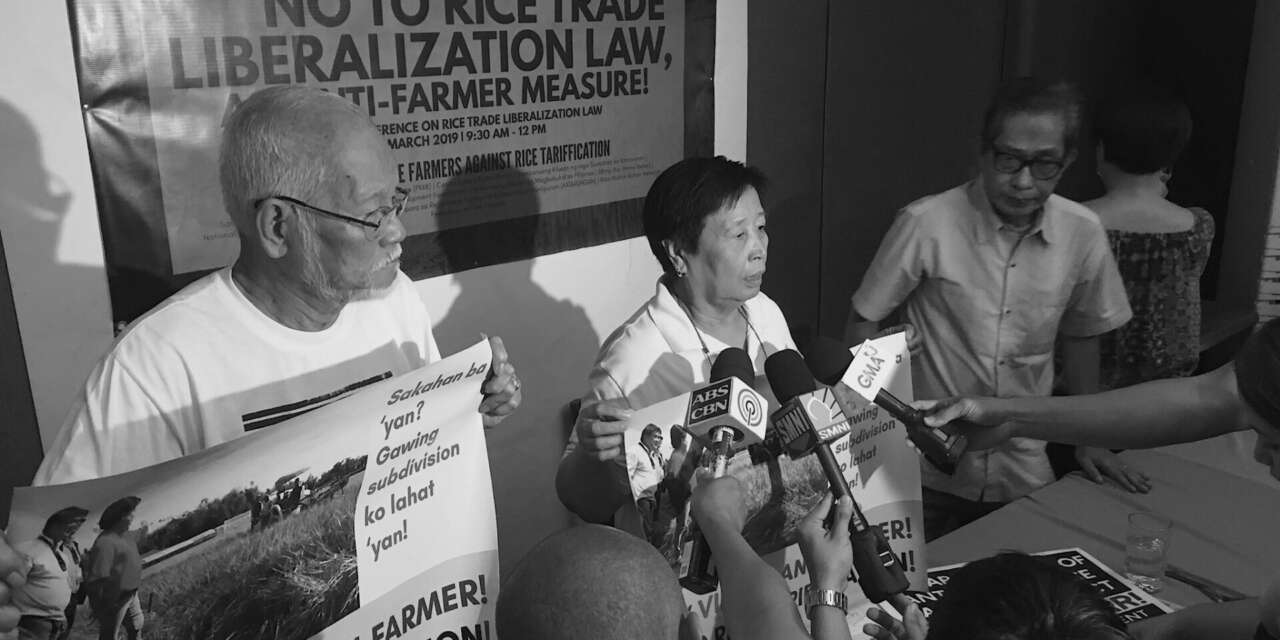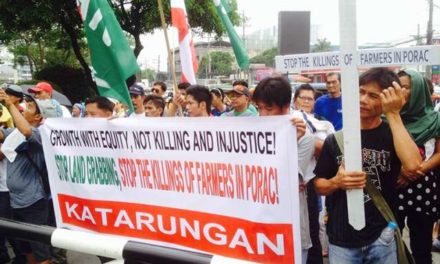There are various adjectives that people use to describe Philippine agriculture these days, but “healthy” is not one of them. Most often, the adjective is “neglected.” Sometimes, “stagnant.” But perhaps the most accurate is “dying.”
Duterte’s Insight
At the start of his victory speech in Davao on June 4, 2016, President-elect Rodrigo Duterte unexpectedly launched into an attack on the World Trade Organization, saying that the “onslaught of the WTO on an unprepared country” had created a crisis for sugar, rice, and other agricultural products. “We have become dependent on importation. You can no longer go to any country in ASEAN and say we won’t buy your products because we can produce it here. We have to buy them.” [1]
One may disagree with the president on many things, as I do, but on this matter, the central cause of the crisis of Philippine agriculture, he was right on the mark.
The fight over becoming a member of the World Trade Organization during the presidency of President Fidel Ramos was the most important struggle over economic policy in the first two decades of the 21st century. Those who opposed membership lost the battle but they were correct that the consequences would be terrible for Philippine agriculture. The vibrant and efficient agriculture creating “500,000 new jobs a year” that had been promised by advocates of membership did not materialize. Instead, our agriculture went into a tailspin.
Destabilizing Philippine Agriculture
In the years prior to our joining the WTO, our annual agricultural trade was most often in surplus. The last time our agricultural trade was in surplus was in 1993. Since we joined the WTO in 1995, our agricultural trade went into deficit, growing from $149 million in 1995 to $960 million in 2005 to a whopping $7.9 billion in 2019.[2]
Twenty-six years after we joined the WTO, not only have we eliminated all quotas on agricultural products–including the last one, on rice, in 2019; according to the the US Department of Agriculture, Philippine tariffs, which replaced quotas, are now “among the lowest in the region and often close to the preferential rates” offered to members of ASEAN.[3] Not surprisingly, import penetration of almost all agricultural commodities is quite high, translating into huge profits for foreign producers and local importers and into a permanent crisis for local producers. The Philippines is, in fact, a classic example of how to turn a highly self-sufficient agricultural economy into a highly import-dependent one.
The reason often given for the reversal of agricultural trade from surplus to deficit is that Filipino farmers are inefficient, that their costs of production are too high, making them uncompetitive with foreign exporters. This is a case of a falsehood repeated often enough that it takes on the status of truth, to paraphrase Joseph Goebbels, Hitler’s propaganda chieftain. The explanation, rather, is that our farmers can’t compete because our agricultural market has become a dumping ground for foreign commodities that can be sold at dirt cheap prices because their producers are highly subsidized. This is very clear with respect to the US and the European Union, the two biggest exporters of agricultural products to the Philippines.
In the nearly three decades since we entered the WTO, the US has become the country’s top supplier of agricultural goods, accounting for 21 per cent of imports, followed by the European Union, whose share is 11 per cent.[4] This is no cause for surprise since state subsidies for American and European Union farmers are the highest in the world. In 2020, the US agricultural sector received a record $46.8 billion in subsidies, which translated to government subsidizing 39 per cent of the average American farmer’s cost of production.[5] In the European Union, total subsidies have totaled over 50 billion euros yearly, translating to the average European Union farmer being subsidized to the tune of 20 per cent of the cost of production.[6] With such a huge chunk of their cost of production covered by government subsidies, one can no longer speak about US and European Union agriculture as being run on free market lines but as socialist agriculture.
Now, I have no problem with socialist agriculture, but when the two biggest global producers practice socialist subsidization in a global capitalist trading system where smaller producers like the Philippines engage in the free market, the result is massive dislocation and marginalization for the latter. The reason is that massive subsidization has what experts have describes as the “pernicious” effect of promoting overproduction in the US and the European Union, and this leads to dumping of excess produce in world markets, leading to lower world prices for agricultural commodities.[7] Those prices cannot be matched by local farmers, who have to foot the total cost of production themselves since that they run on a purely free market system and enjoy little or no subsidies from government that would allow them to be price competitive.
In the case of the Philippines, with the elimination of quotas as decreed by the WTO and the so-called Minimum Access Volumes (MAV’s) providing little protection, dumping of massively subsidized products triggered crises in the corn, pig, poultry, and vegetable sectors, leading to the bankruptcy of large numbers of small and medium producers and increased poverty across the board in a country where poverty had already been concentrated in the rural areas. The desperation of Philippine producers was echoed by one of our negotiators at a meeting of the WTO Agricultural Committee in Geneva: “Our agricultural sectors that are strategic to food and livelihood security and rural employment,” he told the body, “have already been destabilized as our small producers are being slaughtered in our own markets, [and] even the most resilient and efficient are in distress.”[8]
The much-publicized opposition to large-scale pork imports by hog farmers in 2020 to make up for the short-fall in domestic supply caused by the spread Asian Swine Flu owed itself to their fears that, having been swamped periodically by unwarranted surges in pork imports in the past, the ASF virus would serve as the excuse for the technocrats at the Department of Agriculture to permanently institutionalize massive importing, allegedly to benefit consumers.
The Agony of Rice Farming
The agony of our rice agriculture had been going on for three decades before President Duterte signed the Rice Tariffication Act in 2019 that effectively put an end to its suffering by proclaiming a death sentence.
Under the Agreement of Agriculture (AOA) of the WTO, developing countries were allowed to retain a quota or import restriction on one commodity. In the case of the Philippines, it was rice. The country was required to import rice that amounted to 4 per cent of domestic consumption and none beyond that. But, in fact, the government imported amounts far beyond the figure demanded by the agreement, with imports shooting up from 263,000 MT (metric tons) in 1995 to 2.1 million MT in 1998, 836,999 MT in 1999, and 639,000 MT in 2000. High levels of imports continued over the next two decades, the figure being dependent not so much on estimates of domestic consumption but on the lobbying power of domestic rice importers and foreign exporters at the National Food Authority, making the NFA one of the most corrupt agencies of the government.
The impact on our rice producers was disastrous, since it was near to impossible to compete with super-subsidized Thai rice and Vietnamese rice, which President-elect Duterte in June 2016 correctly identified as the sources of the misery of our rice farmers. For instance, under the Rice Farmer Assistance Program that was in place from 2011 to 2014, the Thai government paid farmers about $450 a metric ton for their rice. Because that was above the market price for rice, stocks mounted, shooting up to 15 million tons, leading the government to dump rice into the export market for $380 to $390 a metric ton to recoup part of the cost of its subsidies. [9]
Similarly, in Vietnam, the government subsidizes its farmers to the tune of $236 per metric ton, and the rice purchased in this program has to be exported, that is, dumped at low prices in countries like the Philippines. As in the case of Thailand, dumping rice in global markets is a way to recoup part of the costs of subsidization. And like Thailand, Vietnam was said to greatly breaching the limits set for subsidies by the WTO, which should come to no more than 10 per cent of the value of production.[10]
The common assumption is that the ending of the rice quota and its replacement with tariffs with the passage of the Rice Tariffication Act came about owing to concerns about rice security. In fact, the quota had been breached so many times in the previous 27 years, not owing to a real shortfall in supply but to the pressure of the powerful rice import lobby. But one actor wanted to repeal it altogether, and that was the United States, which was the informal but main enforcer of WTO rules on member countries as it aggressively tried to open up markets for its heavily subsidized products.
The quota on rice imports was supposed to end on June 30, 2012, but in July 2014, under pressure from rice farmers, the Philippines was able to secure an agreement with the WTO extending it to July 2017. To get the US nod on this extension, however, the Philippines committed to signing a bilateral agreement reducing its tariffs on a variety of agricultural products, including buttermilk, cheese, grapes, poultry, and walnuts.[11] Under pressure from the US, the Duterte administration agreed not to seek an extension of the rice quota after 2017 and begin moves to draft a law to replace the quota with tariffs. How the full court press of Washington achieved the desired goal is recounted with candor by the US Trade Representatives’ Office:
The Philippine President issued Executive Order No. 23 in May 2017, which unilaterally extended [to the US] tariff concessions (e.g., for mechanically deboned poultry meat) until the Philippines enacted a law on the tariffication of rice. While the Philippine Congress considered the rice tariffication law, the United States encouraged Philippine industry to advocate for maintaining tariff concessions as a way to stimulate economic activity and ensure affordable food prices. As part of an October 2018 Joint Statement concluded under the United States-Philippines TIFA, the Philippines recognized the U.S. interest in the extension of Philippine tariff rates on certain agricultural products. The Philippines also committed to expeditious consideration of petitions for the extension of such rates, consistent with established procedural rules.[12]
The agency then points out that the upshot of all this lobbying was that the “Philippine President signed rice tariffication legislation into law on February 14, 2019,”[13] replacing rice quantitative restrictions with a 35 per cent import tariff.
During his last State of the Nation address on July 26, 2021, President Duterte appeared to have forgotten his assertion five years earlier that the WTO was principally responsible for the crisis of Philippine rice agriculture. He offered no justification for the sentence of death he had given it, the Rice Tariffication Act of 2019, except a limpid statement it would stabilize the country’s supply of rice and that the revenues from it would be spent on modern agricultural machinery.[14] But then there was no way of prettifying his waving the white flag. Even the most pro-tariffication study, one done by the Philippine Institute of Development Studies in February of 2021, could not dispute the fact that “[R]ice tariffication ultimately causes an increase in income poverty, across a variety of measures, geographic categories, and time,” [15] because they would not be able to compete with cheap, subsidized rice.
It is true that Philippine agriculture was not in the best of health when we entered the WTO in 1995, but the cure, import liberalization on our part as the rich countries maintained their highly subsidized trade structures was a cure far worse than the disease. As the leading agricultural policy think tank, the Washington, DC-based International Food Policy Research Institute (IFPRI), warned, “[W]ithout reform of agricultural trade barriers in industrialized countries, import liberalization in the developing world will perpetuate unfair competition.”[16]
The Absentee State
While being the central cause of the crisis of Philippine agriculture, WTO-imposed liberalization was not the only problem. Another was a state that was content to leave agriculture in a state of neglect, benign or otherwise. As other developing countries, such as Thailand and Vietnam, poured money into subsidies, research and development, and infrastructure, the Philippines skimped on spending. A good part of the reason is that the structural adjustment programs imposed by the World Bank and the IMF beginning with the presidencies of Corazon Aquino and Fidel Ramos in the late eighties and early nineties left very little money for capital expenditures after spending for personnel and operations.
Also robbing the country of resources for capital expenditures was the Automatic Appropriations Law requiring that repaying foreign creditors must be prioritized in the budget, which meant that some 20 to 40 per cent of the budget annually was allocated to foreign debt service in the period from 1986 to 2015.
From 5.5 per cent of the total budget during the Marcos regime, funding for agriculture dwindled in succeeding administrations, coming to 3.6 per cent during the nine-year reign of Gloria Macapagal Arroyo. [17] By the end of the Arroyo administration, the area under irrigation, at 1.3 million out of 4.7 million hectares, was practically the same as that under Marcos a quarter of a century earlier.[18] Crop yields sagged across the board: the average of 2.8 metric tons of rice per hectare was way below the yields in China and Vietnam. [19] Farm to market roads are key to agricultural productivity but by the end of the 1990’s, only 17 per cent of the Philippines road network was paved, compared with 82 per cent in Thailand and 75 per cent in Malaysia.[20] The parlous state of government support was underlined by the fact that although the Agreement on Agriculture allowed countries a rate of subsidization of 10 per cent of the total value of production, the Philippines could only manage an average of four per cent overall, with government market price supports for rice at a measly five per cent and for corn at one per cent.[21]
The Agrarian Reform Mess
Another major reason for the crisis of Philippine agriculture have been the uncertainties surrounding the agrarian reform program. After nearly 35 years, the agrarian reform program has stalled. As of 2015, some 700,000 hectares remained undistributed—about 450,000 of which were private lands that were among the most productive in the country.[22]
The backlog in land redistribution was not the only problem. Support services were severely underfunded and, in many instances, not provided at all to land reform beneficiaries. Equally problematic was the lack of security of tenure. Many land reform beneficiaries were actually nominal titleholders for landlords seeking to maintain effective control of “redistributed” lands. Moreover, in many parts of the country, landlords brought cases against beneficiaries that had already received certificates of land ownership (CLOAs) in an effort to regain their lands.[23]
Pervasive insecurity of property rights discouraged smallholders from investing to make their land more productive and banks from providing credit to them. As a result, as one study put it, “large numbers [of farmers] have been abandoning the countryside for what they see as the lack of opportunities resulting from persisting inequalities and the absence of incentives. Their logic is compelling: better to take your chances in Saudi Arabia than scratch a living from land from which you can get evicted any time.”[24] Agrarian reform need not be a drag on development. In fact, it can be the engine of development, as was the case in South Korea and Taiwan. The Philippines, in contrast, is an object lesson on the perils of half-way or indecisive agrarian reform.
The Anti-Agriculture Mindset
The parlous state of agriculture is also connected to the fact that the most dynamic sectors of the economic elite appear to have lost interest in agriculture as a source of wealth. As sociologist Kenneth Cardenas has argued, Filipino capitalists value land as a source of wealth, but instead of using it as a base for agricultural pursuits, they are using it for real estate development not just in the old urban centers but in the suburban periphery.[25] The highest rates of return on investment come from shopping malls, office buildings, middle and upper middle class housing, and tourist attractions in what used to be rice fields.
Where land has not yet been transformed into malls, rural elites often leave them empty and unplanted, waiting for land values to rise as suburban expansion stretches to the rural hinterland, then selling at the “right price” at the “right time.” You just need to travel north and south of Metro Manila to realize that what used to be thousands of hectares of productive farmland in Calabarzon, Bulacan, and Pampanga in the 1990’s have, in the twinkling of an eye, been turned into an urban landscape.
There appears to be more than narrow economic calculus at work in the decline of the countryside. Much development thinking among technocrats, economists, and the business sector is centered on improving the atmosphere for business activities in the city, promoting a dynamic real estate industry, supporting the growth of financial services, and attracting more investment in BPO (“Business Process Outsourcing”) activities. Development is anchored on servicing the needs of a growing globalized middle class. In this mindset, agriculture is an afterthought, and food security is one that can be met with increased imports.
In this paradigm, the over 50 per cent of the population that rely on agriculture or agriculture-related activities for their living are caught up in a low-value-added enterprise that is not a dynamic source of development, the main engine of which is seen to be urban economic activities fueled by foreign investment, financial services, and billions of OFW remittances. From this perspective, the bulk of the population that remains in agriculture is “excess baggage” constituting a drag on development, the main solution to which is not to make them more productive but to siphon their ranks to overseas work to earn dollars that can then be recycled to their families to spend in urban consumption.
What is to be Done?
For those that believe that agriculture is critical to our economy, our society, and our culture, there are important measures to be taken to revive this neglected sector.
First, it is important to find ways to stop or reduce the dumping of foreign agricultural commodities on our agricultural markets, using both those mechanisms allowed by the WTO and those that may not. Owing to US unilateralism that has paralyzed the dispute settlement system, the WTO Is today a much weaker body than it was 26 years ago. Skillful legal navigation can enable us to escape fulfilling many of its onerous impositions without incurring penalties, as many countries, such as Vietnam and Thailand, are doing, despite protests from the US and the WTO.
Second, agrarian reform must be decisively completed and supported with adequate support services and strong legal action must be made available to prevent landlords from retaking land. A prosperous agriculture based on successful land reform converted the countryside in Taiwan and Korea into a beehive of prosperous smallholders whose demand triggered their industrial take-off in the 1960’s and early 1970’s. With enough political will, the Philippines can follow in their footsteps.
Third, government must no longer be simply a passive force but serve as an active developmental agent that furnishes the support for small and medium landholders that mere market incentives cannot provide. This support should be in three forms: one, programs such as direct assistance and credit support that enable farmers to improve their performance; two, legal assistance to secure security of tenure, and three, leadership in providing a vision of a dynamic agricultural future and assistance in organizing farmers as an effective pressure group.
Four, we must abandon the anti-agricultural bias of neoliberal technocrats and economists who see agriculture in narrow terms as a loss-making activity that entails a large opportunity cost from more profitable ventures and make it serve instead, with the right policies, as the engine of a development process that brings about prosperous, equitable, and sustainable development. In short, we must get rid of a mentality that results in agrocide.
Finally, and perhaps this is the most difficult challenge, our agriculture must be adapted to the needs of an era of rapid climate change and environmental crises. With its low carbon intensity, small-scale agriculture that combines ecologically resilient traditional technology with advanced technology has increasingly been seen as the best way to do agriculture in the era of climate change. The economic interest of small farmers and the well-being of the climate are increasingly converging, and government can play a positive role in accelerating their convergence.
Philippine agriculture is dying. It will take decisive steps to save it—and the Development Bank of the Philippines can contribute to this challenge.#
*Walden Bello is chairperson of the Board of Rights, a farmers’ support organization and senior analyst at the Bangkok-based think tank Focus on the Global South. He is the author of The Food Wars (2009) and co-author of Development Debacle: The World Bank in the Philippines (1982), The Anti-Development State: The Political Economy of Permanent Crisis in the Philippines (2004), and State of Fragmentation: The Philippines in Transition.
This article is drawn from a presentation at a seminar of the Development Bank of the Philippines on August 5, 2021 and will appear as a two-part series in Rappler.
[1] “Rodrigo Duterte’s Speech at His Thanksgiving Party,” June 4, 2016, Youtube, https://www.youtube.com/watch?v=XXNv7qetYKA
[2] Philippine Statistical Authority, Selected Agricultural Statistics, 1997, 2007, 2016, 2020
[3] USDA Foreign Agricultural Service, “Philippines 2019 Export Highlights,” https://www.fas.usda.gov/philippines-2019-export-highlights
[4] Ibid.
[5] Chuck Abbott, “Record-High Agricultural Subsidies to Supply 39 per cent of Farm Income,” Successful Farming, March 12, 2020, https://www.agriculture.com/news/business/record-high-ag-subsidies-to-supply-39-of-farm-income
[6] Ian Mitchell and Arthur Baker, “New Estimates of European Union Agricultural Support,” Center for Global Development, Nov 2019, pp. 1-2.
[7] Ibid.
[8] Submission of the Republic of the Philippines, World Trade Organization Committee on Agriculture, Geneva, July 1, 2003.
[9] Forrest Laws, “Rice subsidy program cost Thailand $27 billion,” Farm Progress, April 3, 2015, https://www.farmprogress.com/rice/rice-subsidy-program-cost-thailand-27-billion
[10] Ibid.
[11] United States Trade Representative’s Office, 2021 National Trade Estimate on Foreign Trade Barriers (Washington, DC: USTR, 2021), p. 418.
[12] Ibid.
[13] Ibid.
[14] CNN Philippines, “Full Text: President Rodrigo Duterte’s 2021 State of the Nation Address,” July 21, 2021, https://cnnphilippines.com/news/2021/7/27/Duterte-SONA-2021-full-text.html
[15] Roehlano Briones, “Does Rice Tariffication in the Philippines Worsen Income Poverty?,” Policy Notes, Philippine Institute of Development Studies (PIDS), No. 2021-02 (Feb 2021), p. 6.
[16] Quoted in “Trade Facts,” Business World, Sept 5-6, 2003, p. 28.
[17] Government data provided by Riza Bernabe, personal communication, May 5, 2008.
[18] Walden Bello, “The Philippines: Failed State, Failed Economy,” in Walden Bello et al., State of Fragmentation: The Philippines in Transition (Manila: Focus on the Global South, 2014), p. 14.
[19] Rovik Obanil, “Rice Safety Nets Act: More of a Burden than a Shield,” Farm News and Views (1st Quarter 2002), p. 10.
[20] Bello, ibid.
[21] Walden Bello et al., The Anti-Development State: The Political Economy of Permanent Crisis in the Philippines (Manila: Anvil, 2009), p. 151.
[22] Mary Ann Manahan, “Agrarian Atrophy and the Changing Countryside,” in Bello et al., State of Fragmentation, p. 112.
[23] Ibid., p. 110.
[24] Bello, “The Philippines: Failed State, Failed Economy, p. 16
[25] Kenneth Cardenas, “Urban Property Development and the Creative Destruction of Filipino Capitalism,” in State of Fragmentation, pp. 35-65.








